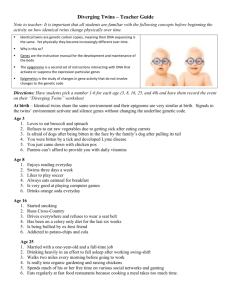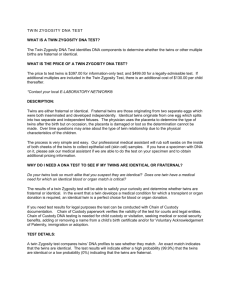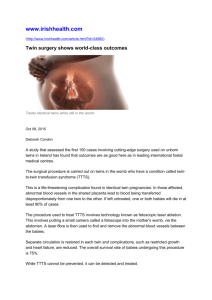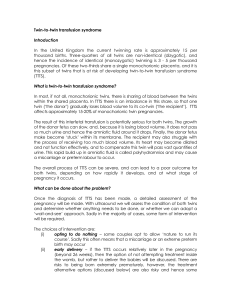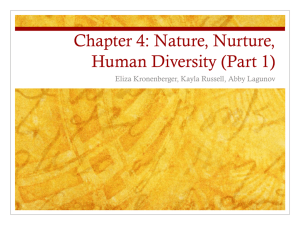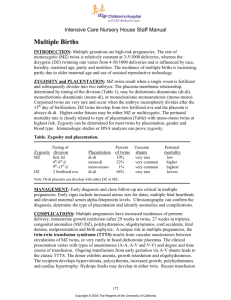Chromosomal abnormalities in twins
advertisement
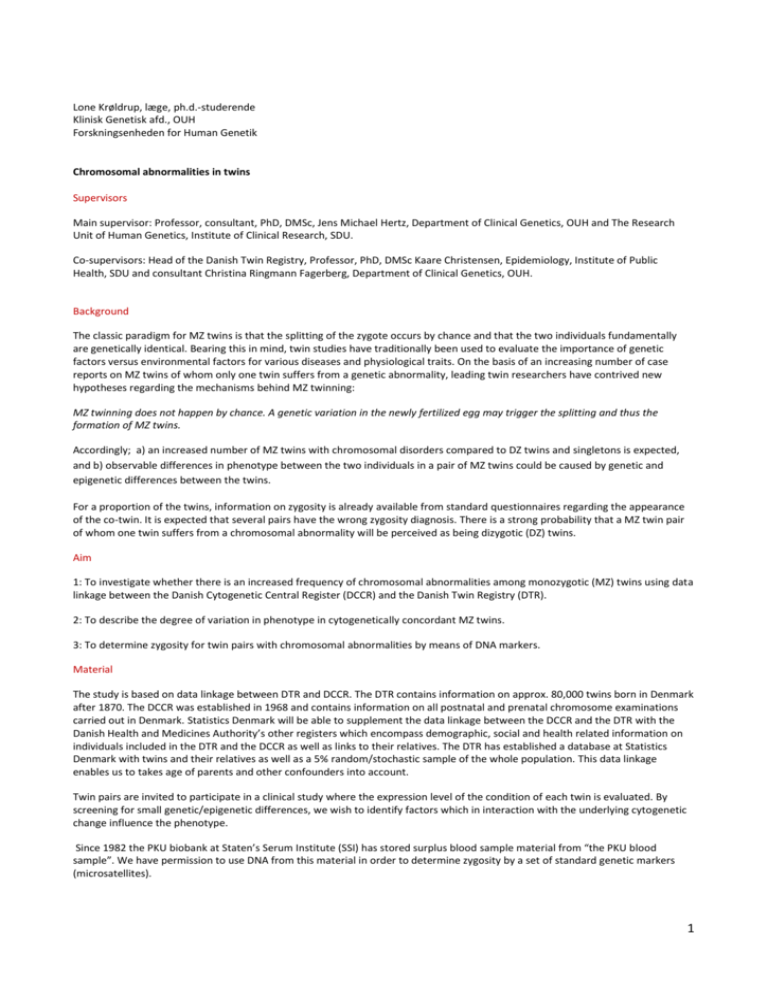
Lone Krøldrup, læge, ph.d.-studerende Klinisk Genetisk afd., OUH Forskningsenheden for Human Genetik Chromosomal abnormalities in twins Supervisors Main supervisor: Professor, consultant, PhD, DMSc, Jens Michael Hertz, Department of Clinical Genetics, OUH and The Research Unit of Human Genetics, Institute of Clinical Research, SDU. Co-supervisors: Head of the Danish Twin Registry, Professor, PhD, DMSc Kaare Christensen, Epidemiology, Institute of Public Health, SDU and consultant Christina Ringmann Fagerberg, Department of Clinical Genetics, OUH. Background The classic paradigm for MZ twins is that the splitting of the zygote occurs by chance and that the two individuals fundamentally are genetically identical. Bearing this in mind, twin studies have traditionally been used to evaluate the importance of genetic factors versus environmental factors for various diseases and physiological traits. On the basis of an increasing number of case reports on MZ twins of whom only one twin suffers from a genetic abnormality, leading twin researchers have contrived new hypotheses regarding the mechanisms behind MZ twinning: MZ twinning does not happen by chance. A genetic variation in the newly fertilized egg may trigger the splitting and thus the formation of MZ twins. Accordingly; a) an increased number of MZ twins with chromosomal disorders compared to DZ twins and singletons is expected, and b) observable differences in phenotype between the two individuals in a pair of MZ twins could be caused by genetic and epigenetic differences between the twins. For a proportion of the twins, information on zygosity is already available from standard questionnaires regarding the appearance of the co-twin. It is expected that several pairs have the wrong zygosity diagnosis. There is a strong probability that a MZ twin pair of whom one twin suffers from a chromosomal abnormality will be perceived as being dizygotic (DZ) twins. Aim 1: To investigate whether there is an increased frequency of chromosomal abnormalities among monozygotic (MZ) twins using data linkage between the Danish Cytogenetic Central Register (DCCR) and the Danish Twin Registry (DTR). 2: To describe the degree of variation in phenotype in cytogenetically concordant MZ twins. 3: To determine zygosity for twin pairs with chromosomal abnormalities by means of DNA markers. Material The study is based on data linkage between DTR and DCCR. The DTR contains information on approx. 80,000 twins born in Denmark after 1870. The DCCR was established in 1968 and contains information on all postnatal and prenatal chromosome examinations carried out in Denmark. Statistics Denmark will be able to supplement the data linkage between the DCCR and the DTR with the Danish Health and Medicines Authority’s other registers which encompass demographic, social and health related information on individuals included in the DTR and the DCCR as well as links to their relatives. The DTR has established a database at Statistics Denmark with twins and their relatives as well as a 5% random/stochastic sample of the whole population. This data linkage enables us to takes age of parents and other confounders into account. Twin pairs are invited to participate in a clinical study where the expression level of the condition of each twin is evaluated. By screening for small genetic/epigenetic differences, we wish to identify factors which in interaction with the underlying cytogenetic change influence the phenotype. Since 1982 the PKU biobank at Staten’s Serum Institute (SSI) has stored surplus blood sample material from “the PKU blood sample”. We have permission to use DNA from this material in order to determine zygosity by a set of standard genetic markers (microsatellites). 1 2


